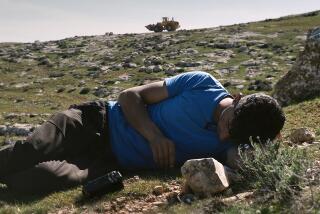Review: The frustrating ‘Tears of Gaza’ leaves too much unsaid
- Share via
“Tears of Gaza” is both horrifying and frustrating. This documentary’s goals are noble ones, but its execution is something else again.
Norwegian director Vibeke Lokkeberg was motivated to make the film by watching television footage of the intense Israeli bombing of Gaza in 2008.
Disturbed about the attacks on civilian targets and by Israel’s refusal to allow outside crews into Gaza, she eventually contacted a handful of Palestinian cameramen who shot footage for her during the attacks, which she and her team later assembled.
On the one hand, it is impossible to overstate how truly nightmarish the scenes in “Tears of Gaza” are. The images we see, shot in hospital emergency wards and in the rubble of just-bombed buildings, are unrelentingly, almost unendurably graphic. Watching these situations without being upset at the horror of it all is simply not possible.
Though amplification really isn’t necessary, “Tears of Gaza” augments this footage with interviews, some shot by Lokkeberg, often with young children who have been severely traumatized by the bombing, either because of personal injury or death in the family or both.
In a director’s statement included in the movie’s press material, Lokkeberg says that the motivating idea behind “Tears of Gaza” was “a protest against all wars.” Her husband and producer, Terje Kristiansen, agrees, saying his goal for the film is “to show how civilians, women and children are the victims of war.”
Regrettably, “Tears of Gaza” does not play out as anything like this kind of generic denunciation of the awfulness of civilian devastation. It appears on the screen, with much more specificity than the filmmakers are willing to acknowledge, as a blanket indictment of the state of Israel as the merciless incarnation of unadulterated evil.
Not surprisingly, given the violence of the bombing, almost every Palestinian interviewed is furious with the attackers, and phrases such as “may God punish the Israelis” are endlessly repeated. Lokkeberg also takes pains to include footage of Israeli warships, drones and helicopters, carefully edited in to magnify the sense of omnipotent menace.
What is missing in all of this is any sense of context, any understanding of the long and dreadful history of mutual violence between Israel and the Palestinians. Whether military actions like these are excusable or not, if you decide that your mission is so noble that you don’t even have to make an attempt to present Israel’s rationale, you are creating one-sided propaganda whether you know it or not. And if you are making propaganda, the last thing that tormented region of the world needs, you are not the vanguard of the solution but an integral part of the problem.
To put this another way, imagine a film composed entirely of the dreadful footage that is available of the human carnage that suicide bombers caused among innocent civilians in Israel, supplemented with interviews from children who lost parents in the blasts, parents who lost children, etc., all screaming for the heads of the nearest Palestinians. Such a film would certainly be emotionally powerful, but it would not shed any meaningful light on the situation.
One of the most frustrating things about “Tears of Gaza” is that, because the footage used is so disturbing, the filmmakers could have made the kind of indictment of the effects of war on the innocent that they think they have. All they would have had to do was to let the horrors speak for themselves, without any interviews at all, but the temptation to put a thumb on this film’s moral scale was more than they could resist.
The one-sided self-righteousness of “Tears of Gaza,” joined to the stomach-turning images it conveys, call to mind the thoughts of groundbreaking historian Amos Elon, author of “The Israelis: Founders and Sons,” who feared of the Israeli-Palestinian impasse that the situation’s enormous demands for justice might exceed the human capacity to administer justice. If this film is any indication, that may prove to be the case.
More to Read
Only good movies
Get the Indie Focus newsletter, Mark Olsen's weekly guide to the world of cinema.
You may occasionally receive promotional content from the Los Angeles Times.











